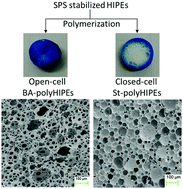This month we look at three articles that feature in Polymer Chemistry that report the use of polymers in emulsions. Both in emulsion polymerisation and high internal phase emulsions.
Emulsion polymerisation can be utilised to prepare polymers as polymeric particles with high solids content, and is commonly used in industry and academia alike. Seeded emulsion polymerisation is a technique where a seed particle is utilised in an emulsion polymerisation, to overcome any variability in the nucleation step.
High internal phase emulsions (HIPE) are those that have a droplet (internal) phase that constitutes 74.05% or more of the total emulsion volume. PolyHIPEs have gained a great deal of interest, where the polymerisation occurs in the continuous phase forming voids around the dispersed droplets, leading to highly porous materials.
1. Impressed pressure-facilitated seeded emulsion polymerization: design of fast swelling strategies for massive fabrication of patchy microparticles
Lei Tian, Xue Li, Panpan Zhao, Zafar Ali, Qiuyu Zhang
Polym. Chem., 2016, 7, 7078-7085; DOI: 10.1039/C6PY01778A
The authors present a pressure-facilitated seeded emulsion polymerisation of poly(glycidyl methacrylate)/poly(styrene), whereby the utilisation of high pressure and temperature allowed for an accelerated seed swelling process, overcoming typical disadvantages of seeded emulsion polymerisation. The resulting particles could be designed to be patchy and anisotropic in shape, through tuning the polymerisation time and dibutyl phthalate/styrene ratios.
2. Rational design of functionalized polyacrylate-based high internal phase emulsion materials for analytical and biomedical uses
Gloria Brusotti, Enrica Calleri, Chiara Milanese, Laura Catenacci, Giorgio Marrubini, Milena Sorrenti, Alessandro Girella, Gabriella Massolini, Giuseppe Tripodo
Polym. Chem., 2016, 7, 7436-7445; DOI: 10.1039/C6PY01992G
PolyHIPEs (with water contents of 80-90%) were designed through the polymerisation of (meth)acrylate monomers: butyl acrylate, glycidyl methacrylate and trimethylolpropane triacrylate as the oil phase. Various parameters were optimised, such as the monomer, cross-linker and surfactant concentrations, to give structural porous polyHIPEs with interesting morphology, thermal stability and porosity. The materials have potential for the immoblization of biomolecules for various applications.
3. Closed-cell and open-cell porous polymers from ionomer-stabilized high internal phase emulsions
Tao Zhang, Zhiguang Xu, Qipeng Guo
Polym. Chem., 2016, 7, 7469-7476; DOI: 10.1039/C6PY01725H
PolyHIPEs were prepared, utilising an ionomer as a stabiliser and either styrene (Sty) or butyl acrylate (BA) as the continuous phase. Sty based polyHIPEs resulted in closed-cell pores, whereas BA gave open-cell structures. When increasing the internal phase, the average pore diameters in the Sty polyHIPES decreased, whilst the average pore diameters for the BA polyHIPEs increased. Also, the amphiphilicity of the polyHIPEs could be tuned by simply exposing them to different water of different pH values.
Read these articles for free until March 17th
Dr. Fiona Hatton is a web writer for Polymer Chemistry. She is currently a postdoctoral researcher in the Armes group at the University of Sheffield, UK. Find her on Twitter: @fi_hat












